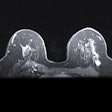
Swedish researchers have found that using MRI for prostate cancer screening finds clinically significant cancer and reduces unnecessary biopsies, according to a study published July 9 in the New England Journal of Medicine.
The study results are not only good news for patients but also for the larger healthcare enterprise, according to a group of researchers led by Martin Eklund, PhD, of the Karolinska Institute in Stockholm, Sweden.
"The reduced biopsy rate and potential downstream savings that result from less overtreatment offer potential cost savings that may offset the additional costs of MRI," the team wrote.
Men with high prostate-specific antigen (PSA) test results typically undergo "standard, systematic" transrectal ultrasound-guided prostate biopsy. But this approach can lead to overdiagnosis -- that is the identification of clinically insignificant cancers (those with Gleason scores of 6 or lower) -- and unnecessary biopsy, they noted. That's why there's been increased interest in using MRI for prostate cancer screening.
"MRI has generated interest as a method for improving prostate cancer diagnostics," Eklund and colleagues wrote. "[It] can identify areas of the prostate suggestive of cancer, which allows prostate biopsies to be targeted toward those areas while unnecessary biopsies can be avoided in men with no visible lesions. In studies involving men referred for biopsy because of clinical suspicion of prostate cancer, targeted biopsy in men with positive findings on MRI ... resulted in less detection of clinically insignificant cancers than standard biopsy while showing similar or better ability to detect clinically significant cancers."
The use of MRI for prostate cancer screening in population-based programs hasn't been thoroughly explored, according to Eklund and colleagues, so they sought to investigate the performance of the modality for this purpose using data from the STHLM3-MRI trial, a study that included information from 12,750 men eligible for prostate cancer screening. Of these, 1,532 had PSA levels of 3 ng per milliliter or higher, which was the main criteria for inclusion in Eklund's and colleagues' research. Men with high PSA levels were randomly assigned to undergo the standard ultrasound biopsy protocol (603 patients) or an MRI exam followed by a combined approach of a standard and targeted biopsy if MRI exam results were positive (929 patients).
The researchers found that MRI-targeted, combined biopsy approach produced statistically comparable results to a standard biopsy protocol when it came to detecting clinically significant cancers. However, it outperformed the standard biopsy protocol in identifying clinically insignificant cancers.
| Performance comparison between standard and MRI-targeted prostate biopsy protocols after positive PSA results | ||
| Measure | Standard prostate biopsy protocol | MRI-targeted prostate biopsy protocol |
| Clinically significant cancers (Gleason score of ≥ 7) | 18% | 21% |
| Clinically insignificant cancers (Gleason score of ≤ 6) | 12% | 4% |
Among men with elevated PSA levels and positive results on MRI exam, using the combined biopsy approach reduced by 64% the number of clinically insignificant tumors identified compared with the standard biopsy approach alone. Better yet, it did not compromise the detection of clinically significant cancers, the team wrote.
"The markedly reduced incidences of unnecessary biopsy and diagnosis of clinically insignificant cancer address key barriers impeding implementation of population-based [MRI] screening for prostate cancer," the authors concluded.



.fFmgij6Hin.png?auto=compress%2Cformat&fit=crop&h=100&q=70&w=100)





.fFmgij6Hin.png?auto=compress%2Cformat&fit=crop&h=167&q=70&w=250)











